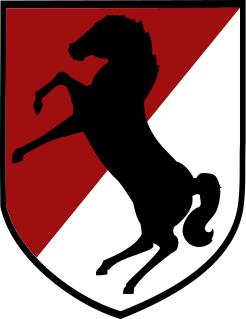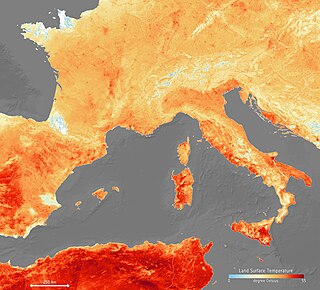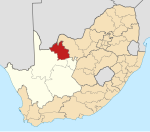
The meerkat or suricate is a small mongoose found in southern Africa. It is characterised by a broad head, large eyes, a pointed snout, long legs, a thin tapering tail, and a brindled coat pattern. The head-and-body length is around 24–35 cm (9.4–13.8 in), and the weight is typically between 0.62 and 0.97 kg. The coat is light grey to yellowish brown with alternate, poorly defined light and dark bands on the back. Meerkats have foreclaws adapted for digging and have the ability to thermoregulate to survive in their harsh, dry habitat. Three subspecies are recognised.

The 11th Armored Cavalry Regiment is a unit of the United States Army garrisoned at Fort Irwin, California. Although termed an armored cavalry regiment, it is being re-organized as a multi-component heavy brigade combat team. The regiment has served in the Philippine–American War, World War II, the Vietnam War, Cold War, Operation Desert Storm, and Operation Iraqi Freedom. The 11th ACR serves as the Opposing Force (OPFOR) for the Army and Marine task forces, and foreign military forces that train at the National Training Center.

Latvian Air Force is the aviation branch of the National Armed Forces. The first Air Force (AF) units were established 1992. It has no air combat capability, thus the defense of Latvian air space is maintained by NATO, with rotating detachments of four aircraft to Lithuania at four-monthly intervals.

The Regiment Huzaren van Boreel is an armoured regiment of the Royal Netherlands Army, named for Willem Francois Boreel. It currently serves in the armoured Intelligence, Surveillance, Target Acquisition, Reconnaissance (ISTAR) role; the regiment provides two armoured reconnaissance squadrons assigned to each of the army's two mechanized brigades, while an STA artillery unit, an electronic warfare unit, Human Intelligence (HUMINT) unit and imagery intelligence unit are all formed into a single battalion attached to the Combat Support Brigade.

The Royal Netherlands East Indies Army was the military force maintained by the Netherlands in its colony of the Netherlands East Indies, in areas that are now part of Indonesia. The KNIL's air arm was the Royal Netherlands East Indies Army Air Force. Elements of the Royal Netherlands Navy were also stationed in the Netherlands East Indies.

No. 313 Squadron RAF was a Czechoslovak-manned fighter squadron of the Royal Air Force in the Second World War.

Meerkat Manor is a British television programme produced by Oxford Scientific Films for Animal Planet International that premiered in September 2005 and ran for four series until its cancellation in August 2008. Using traditional animal documentary style footage along with narration, the series told the story of the Whiskers, one of more than a dozen families of meerkats in the Kalahari Desert being studied as part of the Kalahari Meerkat Project, a long-term field study into the ecological causes and evolutionary consequences of the cooperative nature of meerkats. The original programme was narrated by Bill Nighy, with the narration redubbed by Mike Goldman for the Australian airings and Sean Astin for the American broadcasts. The fourth series, subtitled The Next Generation, saw Stockard Channing replacing Astin as the narrator in the American dubbing.

The Special Forces Support Group (SFSG) is a unit of the British Armed Forces. The SFSG is the newest addition to the United Kingdom Special Forces. It was formed officially on 3 April 2006 to provide specialist infantry and other support to the Special Air Service, the Special Reconnaissance Regiment and the Special Boat Service on operations. A tri-service unit, the major element of the SFSG is 1st Battalion, The Parachute Regiment, reinforced with a company strength group of the Royal Marines. Specialists from the RAF Regiment also form part of the SFSG's strength. The SFSG may provide extra firepower from land or air to fulfil their mission.
The Day the Balloon Went Up is the eighth episode of the third series of the British comedy series Dad's Army that was originally transmitted on Thursday 30 October 1969.

The United States Marine Corps is organized within the Department of the Navy, which is led by the Secretary of the Navy (SECNAV). The most senior Marine commissioned officer is the Commandant of the Marine Corps, responsible for organizing, recruiting, training, and equipping the Marine Corps so that it is ready for operation under the command of the unified combatant commanders. The Marine Corps is organized into four principal subdivisions: Headquarters Marine Corps, the Operating Forces, the Supporting Establishment, and the Marine Forces Reserve.
A Marine expeditionary brigade (MEB) is a formation of the United States Marine Corps, a Marine air-ground task force of approximately 14,500 Marines and sailors constructed around a reinforced infantry regiment, a composite Marine aircraft group, a combat logistics regiment and a MEB command group. The MEB, commanded by a general officer, is task-organized to meet the requirements of a specific situation. It can function as part of a joint task force, as the lead echelon of the Marine expeditionary force (MEF), or alone. It varies in size and composition, and is larger than a Marine expeditionary unit (MEU) but smaller than a MEF. The MEB is capable of conducting missions across the full range of military operations.

Royal Air Force Atcham or more simply RAF Atcham is a former Royal Air Force station located 5.0 miles (8.0 km) east of Shrewsbury, Shropshire, England, on the north eastern boundary of Attingham Park.
The Kalahari Meerkat Project, or KMP, is a long term research project focused on studying the evolutionary causes and ecological consequences of cooperative behaviors in meerkats. The secondary aims of the project are to determine what factors affect the reproductive success of the meerkats and what behavioral and physiological mechanisms control both reproduction and cooperative behavior. The project is also working on monitoring overall plant and animal populations within the reserve and work with the nearby community of Van Zylsrus in the areas of conservation and sustainable use of resources.

Lieutenant General Best Barracks, formerly De Peel Air Base, is a Royal Netherlands Army guided missile base in the Netherlands. It currently has only one, though not actively used, runway.

No. 320 (Netherlands) Squadron RAF was a unit of the Royal Air Force during World War II formed from the personnel of the Royal Netherlands Naval Air Service.
The Battle of Núi Lé was the last major battle fought by Australian and New Zealand forces in South Vietnam. The battle was fought in the former Phước Tuy Province between elements of the People's Army of Vietnam (PAVN) 33rd Regiment and 'B' and 'D' Companies of the 4RAR/NZ (ANZAC) Battalion and during Operation Ivanhoe. Núi Lé, a small hill within Quang Thanh commune in Chau Duc District, is today in Ba Ria-Vung Tau Province.
No. 660 Squadron AAC is a squadron of the British Army's Army Air Corps (AAC). The squadron traces its lineage to a Royal Air Force squadron that existed during the Second World War. In the late 1950s the squadron's numerical was transferred to the AAC and since its formation in 1969, it has operated as a British Army unit flying various types of battlefield helicopters. The squadron has been re-formed and disbanded on a number of occasions. The squadron is currently based at RAF Shawbury where it forms part of No. 1 Flying Training School, but it has been deployed operationally to Northern Ireland, Hong Kong and Brunei throughout its existence.

The June 2019 European heat wave was a period of unusually hot weather affecting southwestern to central Europe, starting in late June and resulting in the hottest June ever recorded in Europe. It was caused by high pressure and winds from the Sahara Desert affecting large parts of the continent, according to meteorologists. It resulted in record-breaking temperatures for the month of June at many locations. France experienced temperatures in excess of 45 °C (113 °F) for the first time in recorded history. A national all-time record high temperature of 46.0 °C (114.8 °F) occurred on 28 June in Vérargues.

The climate of Liverpool features a temperate maritime climate, with relatively mild summers, cool winters and rainfall spread fairly evenly throughout the year. Since 1867, rainfall and temperature records for the city have been kept at Bidston Observatory, as well as atmospheric pressure records since 1845. However, the site closed down in 2002, and a weather station in Crosby has been used by the Met Office since. Irregular meteorological observations have been taken in the city since at least 1768, with unbroken records extending for long periods of time. This includes observations taken at the Liverpool Dock from 1768–1798, an unspecified location from 1772–1799 and West Derby from 1830–1859 and at other unspecified locations in the city from at least 1860 onward. Continuous observations in different areas of the city have been taken since 1830. In modern times, there have also been other stations to operate in the Liverpool area, including: Wallasey (1924–1993), West Kirby (1926–1993), Aigburth (1968–1993), and Liverpool John Lennon Airport (1950–present)

















